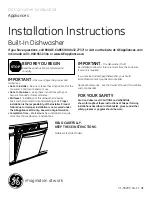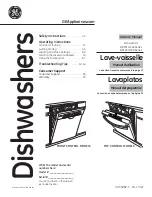
.4.
Loading the Dishwasher
Before placing the dishes in the dishwasher, remove any large
food particles to prevent the filter from becoming clogged. A
clogged filter will result in reducing performance.
If the pots and pans have baked-on food that is extremely hard
to remove, we recommend that they be allowed to soak before
they are washed. This will eliminate the need for extra wash
cycles.
Pull out the rack when loading the dishwasher.
How to Use the Lower Rack
We recommend that you place the most difficult to clean items
on the lower rack: pots, lids, serving dishes and bowls, as shown
in the figure to the right.
It is preferable to place serving dishes and lids on the sides of the
racks in order to avoid blocking the rotation of the top spray arm.
- Pots, serving bowls, etc. must always be placed face down.
- Deep pots should be slanted to allow the water to flow out.
- The silverware basket can be doubled (see fig.A) so that only
one section may be used when the silverware load is light. This
also makes space for additional pots and pans, and it can also
be placed in the upper rack.
- Silverware should be placed in the silverware basket with the
handles at the bottom. If the rack has side baskets, the spoons
should be loaded individually into the appropriate slots. Long uten-
sils should be placed in the horizontal position at the front of the
upper rack.
How to Use the Upper Rack
The upper rack is designed to hold more delicate and lighter
dishware, such as glasses, cups and saucers, as well as plates,
small bowls and shallow pans. It is recommended that dishes
placed in the upper rack are not too dirty .
Position the dishes and cookware so that they do not get moved
by the spray of water.
The upper rack can be adjusted for height by using the knobs
located on the sides of the rack itself (see fig.B).
Lower Rack
Upper Rack
Load for 12 Standard Settings
fig.A
fig.B
2
1
3
4
.7.
Wash Cycle Table
Cycle
Eco
Button
Fast
Button
Cycle Selection
Information
Description of Cycle
Deter-
gent
Rinse
Aid
Heavy
Heavy
Normal
Rinse
Glassware
Glassware
Pre-Rinse
Very dirty dishes, pots and
pans (not to be used with
delicate items).
Very dirty dishes, pots and
pans. (not to be used with
delicate items)
Dirty dishes pots and pans.
For dishes that need to be
rinsed and dried only.
Economic, fast cycle to be
used for items which are sen-
sitive to higher. Run immedi-
ately after dishes are used.
Economic, fast cycle to be
used for items which are sen-
sitive to higher. Run imme-
diately after dishes are used.
Pre-wash of dishes, pots and
pans while waiting for the
load to be completed after
the subsequent meal.
Pre-wash with cold water.
Rinse with cold water.
Extended wash at 60
K
Rinse with hot water
K
Drying.
Pre-wash with cold water.
Rinse with cold water
K
Extended wash at 50
K
Rinse with hot water
K
Drying.
Rinse with cold water.
Extended wash at 60
K
Rinse with hot water
K
Drying.
Rinse with hot water
K
Drying.
Wash at 50
.
Hot Rinse
KKKKK
Drying.
Wash at 50
K
Rinse with cold water.
Short cold wash to prevent
food residue from drying on
the dishes
K
30g
30g
25g
15g
15g
Normal
25g
Normally dirty dishes pots
and pans. Standard daily
w a s h w i t h E C O b u t t o n
pressed.
Rinse with cold water.
Extended wash at 50
K
Rinse with hot water
K
Drying.
Rinse
For dishes that need to be
rinsed and dried only.
Rinse with hot water
K
Drying.
Summary of Contents for IDF6SE2
Page 1: ......
























